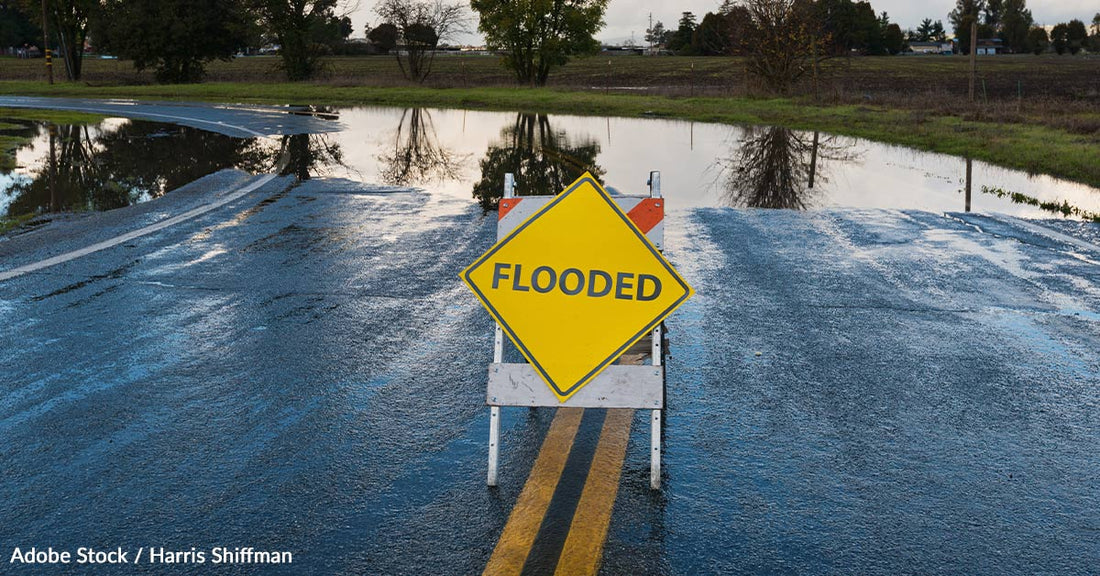California Faces Urgent Flooding Disaster as Powerful Atmospheric Rivers Wreak Havoc
Matthew Russell
The powerful atmospheric rivers that hit California have left at least two people dead and caused significant damage. The Golden State was hit with torrential downpours, flooding, mudslides, and landslides, leaving thousands of people without power. A levee was breached, prompting evacuations, and a firefighter was injured by a falling tree.
The state of California is now facing an urgent flooding disaster. The National Guard and first responders helped people evacuate, with some forced to wade through floodwaters to safety, ABC News reports.
More than 90 rescues have been completed since flooding impacted millions throughout the state, CNN reports.
Life Threatening flash floods in #Springville California.#flashfloods #poleshift #newearth pic.twitter.com/7PXtnmDSz6
— Jacob Woning (@jacobwoning) March 11, 2023
According to the Review-Journal, The town of Pajaro, which holds a population of 1,700, was left in 1 to 3 feet of standing water, and it's estimated that recovery and repairs for area homes could take months.
Arroyo Seco is under mandatory evacuation, and the Pajaro Sunny Mesa Water District has warned customers not to drink the tap water or use it in food preparation due to local wells being flooded, CBS News reports. Further south, evacuation orders for parts of San Luis Obispo County were lifted, but some neighborhoods remained under evacuation warnings. The cities of San Luis Obispo and Morro Bay declared local emergencies.
President Biden approved a disaster declaration in California as a series of severe storms pound the state. 17 million residents are under flood alerts and thousands have been ordered to evacuate. The storm is already being blamed for at least two deaths. pic.twitter.com/gyqrJDkJK2
— CBS Evening News (@CBSEveningNews) March 10, 2023
President Joe Biden declared a federal emergency on Thursday, March 9, to help expedite disaster relief. The state continues to be deluged by atmospheric rivers more powerful than the last, with the Bay Area and Central Coast bearing the brunt of the disaster.
“Soils are very saturated, which will enhance the amount of runoff,” said Patrick Ayd, a meteorologist with the weather service told SFGate. “If you were impacted by previous flooding, expect to see those impacts again. They’ll be even more widespread, as the runoff is even more efficient this time.”
Atmospheric rivers have helped Los Angeles record nearly 21 inches of rain since the season began Oct. 1, 2022, surpassing the average year's 14.77 inches. However, using the scale for atmospheric rivers, the recent storm rates as an AR 3, representing a storm both "beneficial and hazardous."
The National Weather Service's Oxnard office has warned that the next atmospheric river could be more intense and more loaded with precipitation.
The Kern River has run over its banks in Kernville, California. This was the scene earlier this evening as flood waters impacted the community. #CAwx pic.twitter.com/6NYyyujvik
— WeatherNation (@WeatherNation) March 11, 2023
The extreme weather has caused widespread damage, including a sinkhole in the city of Camarillo measuring 30 by 300 feet, KTLA reports. Officials in Kern County have also issued evacuation orders for low-lying areas of the communities of Riverkern and Kernville amid forecasts of flooding. The extreme weather has caused flooding in Atascadero and Paso Robles in the Central Coast, with urgent flood warnings and orders to move out for parts of Monterey County.
The county's Board of Supervisors Chair, Luis Alejo, has said that it's unlikely the levee will be fully repaired before the next storm hits, Yahoo! News reports.
Regions of California are experiencing significant damage. Lives have been lost in the flooding, and lives are still at risk. It's essential that residents stay informed about the weather conditions and take appropriate measures to stay safe.
Atmospheric rivers occur when a narrow band of moisture-rich air moves from the tropics to mid-latitude regions. The moisture can be transported thousands of miles, and when it hits land, it can lead to heavy rainfall, flooding, and landslides. The intense rainfall associated with atmospheric rivers can cause rivers to overflow, flood streets and homes, and cause extensive damage to infrastructure.
Atmospheric rivers are most common along the west coast of North America, particularly in California, where they are responsible for up to 50% of the state's annual precipitation. Other regions where atmospheric flooding can occur include the west coast of South America, the western coast of Europe, and parts of Asia.
The #OrovilleDam main spillway is releasing water for the first time in about 4 years.
Water is flowing at 15,000 cfs currently but could be adjusted based on the storm/flood conservation guidelines. #Oroville #OrovilleDam #California pic.twitter.com/2LMhqd2mPT
— Chloe Curtis (@chloecurtisnews) March 11, 2023
Climate change is expected to intensify atmospheric flooding, making it more frequent and severe. As the atmosphere warms, it can hold more moisture, increasing the amount of water vapor available to form atmospheric rivers. This could lead to more extreme weather events, including floods, droughts, and wildfires, which can have devastating effects on communities and ecosystems.
The swift response to those impacted by these storms are a reminder of the importance of disaster preparedness and the need to take action to mitigate the impact of extreme weather events. Help ensure that people affected by flooding have the aid and resources they need to survive and rebuild when the waters subside. Click below to make a difference!

